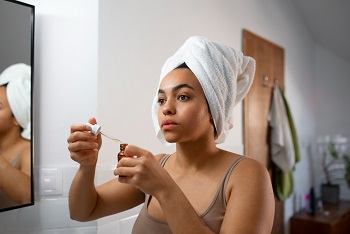Chemical Peel and its Procedures
Chemical Peel and its Procedures
A chemical peel is the number one skin treatment for people, especially women who desire young and glowing skin. Those that are trying to get rid of skin conditions such as acne. It’s a fast and effective skin treatment that requires the attention of an expert. What is a chemical peel? A chemical peel is a cosmetic procedure performed by a doctor, cosmetologist, esthetician, or registered professionals qualified to carry out this type of deep peel. The objective of each session is to improve the texture of the skin, such as scars, acne; promote the production of collagen and new cells by removing the dead skin, using different sources of acids. The acids are between 10% concentration to 70% which refers to the ph of the substance. The total layers of the skin the substance reaches will vary on time and concentration of the acid.
There are three types of peels;
- Mechanical peel: It is the use of abrasive particles to remove the dead skin cells such as microdermabrasion
- Physical peel: Refers to external exfoliations such as the sun.
- Chemical peel: It is a technique that uses a chemical solution that causes the skin to peel off, eliminating the dead cells. As a result of the treatment, the skin texture improves significantly.
Treatment Procedure involved in Chemical Peel
Before applying any chemical peel at any concentration, it is essential that the professional examine your face and tells you what you need and what acid will be applied. Performing a sensitivity test on any part of the forearm is important to avoid an allergic reaction.
Usually, the first step is to remove makeup or dirt on the face by cleaning it with a gentle cleanser, mainly for professional use. The next step is to apply an herbal tonic to regulate the pH of the skin. Afterward, the professional apply one layer of acid at a medium-fast pace and ask the patient what they feel. The number of minutes they leave the acid will depend on the type and concentration of the acid, as some parts of the face could be more sensitive. So everything matters when it comes to the previous examination. Comedones extraction will be the next step.
Finally, the high frequency after the extraction is essential for blood irrigation and soothes inflammation caused by the extraction. As the skin suffered a deep treatment, a collagen mask will make a face recover all the nutrients, and the collagen will improve the healing process.
Before you leave, it is important to talk about sunscreen with the professional and listen to recommendations. Try to avoid direct sun and digital screens for the next few days. The amount of time for a peeling session is approximately 45 minutes to an hour.
There are two kinds of acids used in chemical peel; let’s look at them below.
1. Alpha-hydroxyl acids (AHAs)
Alpha-hydroxyl acids are glycolic acid, mandelic acid, malic acid, lactic acid, citric acid, and tartaric acid. They are natural chemical formulations whose main sources come from many foods, sugar, milk, and fruits. The benefits go from improvements in skin firmness, elasticity, and the reduction of lines and wrinkles. The characteristics and effectiveness of these acids provide a great step in medicine due to the significant results in skin quality.
AHAs are usually applied superficially and medium-depth layers such as those used for:
- Acne
- Scars
- Hyperpigmentation
- Callus
- Age spots
- Seborrhea.
Caution: Most of the current cosmetic creams and serums tend to have AHA in the ingredients. Read the instructions and the acid percentage because some could be unnoticeable, and others could be dangerous. A bad use could lead to a worse result and give unwanted hyperpigmentation in the skin.
2. Beta-hydroxyl acids (BHAs)
Beta-hydroxyl acids have the same purpose as the AHAs, but the difference between the two is the extra carbon molecule that makes the BHAs a lipo-soluble acid. These acids are ideal for acne and oily skin. Even though most people think you can use AHA and BHA daily, it is not recommended unless your qualified professional indicates so. The most common and most popular BHA is Salicylic acid.
Caution: Try to avoid trends and hacks that are not professionally recommended, such as applying lemon juice and sugar as an exfoliant (it is too abrasive for the face and could cause small fissures in the skin) baking soda. On the contrary, you could use honey, yogurt, moisturizers with vitamin C, and retinol in at-home skincare. The recommended creams and serums have to be approved by your qualified professional.
Finally, the number of sessions will vary depending on the skin condition and how satisfied the patient feels about the skin texture. It can be three sessions, usually when you start feeling a significant difference and go up to six to eight sessions. It is hard to say and specify the number of sessions, as the pH is the most important variant besides the type of acid used. The treatment will be specified by the professional, but you have to be aware of the type of acid they are using, the percentage, how many minutes they leave the product on your skin, and most importantly, how you feel during and after the procedure.








Comments (0)